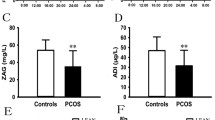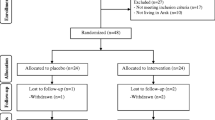Abstract
In this study, our objective was to evaluating the value of serum zinc levels as an etiologic and prognostic marker in patients with polycystic ovarian syndrome. We conducted a prospective study, including 53 women with polycystic ovarian syndrome and 33 healthy controls. We compared serum zinc levels, as well as clinical and metabolic features, of the cases. We also compared serum zinc levels between patients with polycystic ovarian syndrome with insulin resistance. Mean zinc levels were found to be significantly lower in patients with polycystic ovarian syndrome than healthy controls. Multiple logistic regression analysis of significant metabolic variables between polycystic ovarian syndrome and control groups (serum zinc level, body mass index, the ratio of triglyceride/high-density lipoprotein cholesterol, and homocysteine) revealed that zinc level was the most significant variable to predict polycystic ovarian syndrome. Mean serum zinc levels tended to be lower in patients with polycystic ovarian syndrome with impaired glucose tolerance than patients with normal glucose tolerance, but the difference was not statistically significant. In conclusion, zinc deficiency may play a role in the pathogenesis of polycystic ovarian syndrome and may be related with its long-term metabolic complications.


Similar content being viewed by others
References
Franks S (1995) Polycystic ovary syndrome. N Engl J Med 333:853–861
The Rotterdam ESHRE/ASRM-Sponsored PCOS Consensus Workshop Group (2004) Revised 2003 consensus on diagnostic criteria and long-term health risks related to polycystic ovary syndrome. Fertil Steril 81:19–25
Moran L, Norman R (2004) Understanding and managing disturbances in insulin metabolism and body weight in women with polycystic ovary syndrome. Best Pract Res Clin Obstet Gynaecol 18:719–736
Lord J, Wilkin T (2004) Metformin in polycystic ovary syndrome. Curr Opin Obstet Gynecol 16:481–486
Dunaif A, Segal KR, Shelley DR, Green G, Dobrjansky A, Licholai T (1992) Evidence for distinctive and intrinsic defects in insulin action in polycystic ovary syndrome. Diabetes 41:1257–1266
Ciaraldi TP, El-Roeiy A, Madar Z, Reichart D, Olefsky JM, Yen SS (1992) Cellular mechanisms of insulin resistance in polycystic ovarian syndrome. J Clin Endocrinol Metab 75:577–583
Dunaif A (1997) Insulin resistance and the polycystic ovary syndrome: mechanism and implications for pathogenesis. Endocr Rev 18:774–800
Dunaif A, Xia J, Book CB, Schenker E, Tang Z (1995) Excessive insulin receptor serine phosphorylation in cultured fibroblasts and in skeletal muscle. A potential mechanism for insulin resistance in the polycystic ovary syndrome. J Clin Invest 96:801–810
Taylor CG (2005) Zinc, the pancreas, and diabetes: insights from rodent studies and future directions. Biometals 18:305–312
Haase H, Maret W (2005) Protein tyrosine phosphatases as targets of the combined insulinomimetic effects of zinc and oxidants. Biometals 18:333–338
Ehrmann DA (2005) Polycystic ovary syndrome. N Engl J Med 352:1223–1236
Yarali H, Yildirir A, Aybar F et al (2001) Diastolic dysfunction and increased serum homocysteine concentrations may contribute to increased cardiovascular risk in patients with polycystic ovary syndrome. Fertil Steril 76:511–516
Balen A, Rajkowha M (2003) Polycystic ovary syndrome—a systemic disorder? Best Pract Res Clin Obstet Gynaecol 17:263–274
Meyer C, McGrath BP, Teede HJ (2005) Overweight women with polycystic ovary syndrome have evidence of subclinical cardiovascular disease. J Clin Endocrinol Metab 90:5711–5716
Kravariti M, Naka KK, Kalantaridou SN et al (2005) Predictors of endothelial dysfunction in young women with polycystic ovary syndrome. J Clin Endocrinol Metab 90:5088–5095
Tzeng C-R, Chang Y-CI, Chang Y-C, Wang C-W, Chen C-H, Hsu M-I (2014) Cluster analysis of cardiovascular and metabolic risk factors in women of reproductive age. Fertil Steril 1–8. doi:10.1016/j.fertnstert.2014.01.023
Chausmer AB (1998) Zinc, insulin and diabetes. J Am Coll Nutr 17:109–115
Song Y, Wang J, Li X, Cai L (2005) Zinc and the diabetic heart. Biometals 18:325–332
Taneja SK, Kaur R (1990) Pathology of ovary, uterus, vagina and gonadotrophs of female mice fed on Zn-deficient diet. Indian J Exp Biol 28:1058–1065
Ebisch IMW, Thomas CMG, Peters WHM, Braat DDM, Steegers-Theunissen RPM (2007) The importance of folate, zinc and antioxidants in the pathogenesis and prevention of subfertility. Hum Reprod Update 13:163–174
Fenkci V, Fenkci S, Yilmazer M, Serteser M (2003) Decreased total antioxidant status and increased oxidative stress in women with polycystic ovary syndrome may contribute to the risk of cardiovascular disease. Fertil Steril 80:123–127
Archer JS, Chang RJ (2004) Hirsutism and acne in polycystic ovary syndrome. Best Pract Res Clin Obstet Gynaecol 18:737–754
Maret W, Sandstead HH (2006) Zinc requirements and the risks and benefits of zinc supplementation. J Trace Elem Med Biol 20:3–18
Balen AH, Laven JSE, Tan S-L, Dewailly D (2003) Ultrasound assessment of the polycystic ovary: international consensus definitions. Hum Reprod Update 9:505–514
Legro RS (2007) Clinical evaluation of PCOS. In: Azziz R (ed) The polycystic ovary syndrome: current concepts on pathogenesis and clinical care. Springer, New York, pp 17–27
Legro RS, Finegood D, Dunaif A (1998) A fasting glucose to insulin ratio is a useful measure of insulin sensitivity in women with polycystic ovary syndrome. J Clin Endocrinol Metab 83:2694–2698
Dutra RL, Cantos GA, Carasek E (2006) Analysis of zinc in biological samples by flame atomic absorption spectrometry: use of addition calibration technique. Biol Trace Elem Res 111:265–279
Guzel NA, Pınar L, Colakoglu F, Karacan S, Ozer C (2012) Long-term callisthenic exercise-related changes in blood lipids, homocysteine, nitric oxide levels and body composition in middle-aged healthy sedentary women. Chin J Physiol 55:202–209
DeUgarte CM, Bartolucci AA, Azziz R (2005) Prevalence of insulin resistance in the polycystic ovary syndrome using the homeostasis model assessment. Fertil Steril 83:1454–1460
Kechrid Z, Hamdi M, Naziroğlu M, Flores-Arce M (2012) Vitamin D supplementation modulates blood and tissue zinc, liver glutathione and blood biochemical parameters in diabetic rats on a zinc-deficient diet. Biol Trace Elem Res 148:371–377
Kurdoglu Z, Kurdoglu M, Demir H, Sahin HG (2012) Serum trace elements and heavy metals in polycystic ovary syndrome. Hum Exp Toxicol 31:452–456
Dale PO, Tanbo T, Vaaler S, Abyholm T (1992) Body weight, hyperinsulinemia, and gonadotropin levels in the polycystic ovarian syndrome: evidence of two distinct populations. Fertil Steril 58:487–491
Ovesen P, Moller J, Ingerslev HJ et al (1993) Normal basal and insulin-stimulated fuel metabolism in lean women with the polycystic ovary syndrome. J Clin Endocrinol Metab 77:1636–1640
Nazıroğlu M (2012) Molecular role of catalase on oxidative stress-induced Ca(2+) signaling and TRP cation channel activation in nervous system. J Recept Signal Transduct Res 32:134–141
Naziroğlu M (2007) New molecular mechanisms on the activation of TRPM2 channels by oxidative stress and ADP-ribose. Neurochem Res 32:1990–2001
Fenkci SM, Fenkci V, Oztekin O, Rota S, Karagenc N (2008) Serum total L-carnitine levels in non-obese women with polycystic ovary syndrome. Hum Reprod 23:1602–1606
Kurdoglu Z, Ozkol H, Tuluce Y, Koyuncu I (2012) Oxidative status and its relation with insulin resistance in young non-obese women with polycystic ovary syndrome. J Endocrinol Invest 35:317–321
Oteiza PI, Clegg MS, Zago MP, Keen CL (2000) Zinc deficiency induces oxidative stress and AP-1 activation in 3T3 cells. Free Radic Biol Med 28:1091–1099
Beattie JH, Kwun I-S (2004) Is zinc deficiency a risk factor for atherosclerosis? Br J Nutr 91:177–181
Li Y, Zhang H, Jiang C et al (2013) Hyperhomocysteinemia promotes insulin resistance by inducing endoplasmic reticulum stress in adipose tissue. J Biol Chem 288:9583–9592
Kiddy DS, Sharp PS, White DM et al (1990) Differences in clinical and endocrine features between obese and non-obese subjects with polycystic ovary syndrome: an analysis of 263 consecutive cases. Clin Endocrinol (Oxf) 32:213–220
Balen AH, Conway GS, Kaltsas G et al (1995) Polycystic ovary syndrome: the spectrum of the disorder in 1741 patients. Hum Reprod 10:2107–2111
Ghayour-Mobarhan M, Taylor A, New SA, Lamb DJ, Ferns GAA (2005) Determinants of serum copper, zinc and selenium in healthy subjects. Ann Clin Biochem 42:364–375
Galan P, Viteri FE, Bertrais S et al (2005) Serum concentrations of beta-carotene, vitamins C and E, zinc and selenium are influenced by sex, age, diet, smoking status, alcohol consumption and corpulence in a general French adult population. Eur J Clin Nutr 59:1181–1190
Chimienti F, Aouffen M, Favier A, Seve M (2003) Zinc homeostasis-regulating proteins: new drug targets for triggering cell fate. Curr Drug Targets 4:323–338
Author information
Authors and Affiliations
Corresponding author
Rights and permissions
About this article
Cite this article
Guler, I., Himmetoglu, O., Turp, A. et al. Zinc and Homocysteine Levels in Polycystic Ovarian Syndrome Patients with Insulin Resistance. Biol Trace Elem Res 158, 297–304 (2014). https://doi.org/10.1007/s12011-014-9941-7
Received:
Accepted:
Published:
Issue Date:
DOI: https://doi.org/10.1007/s12011-014-9941-7




